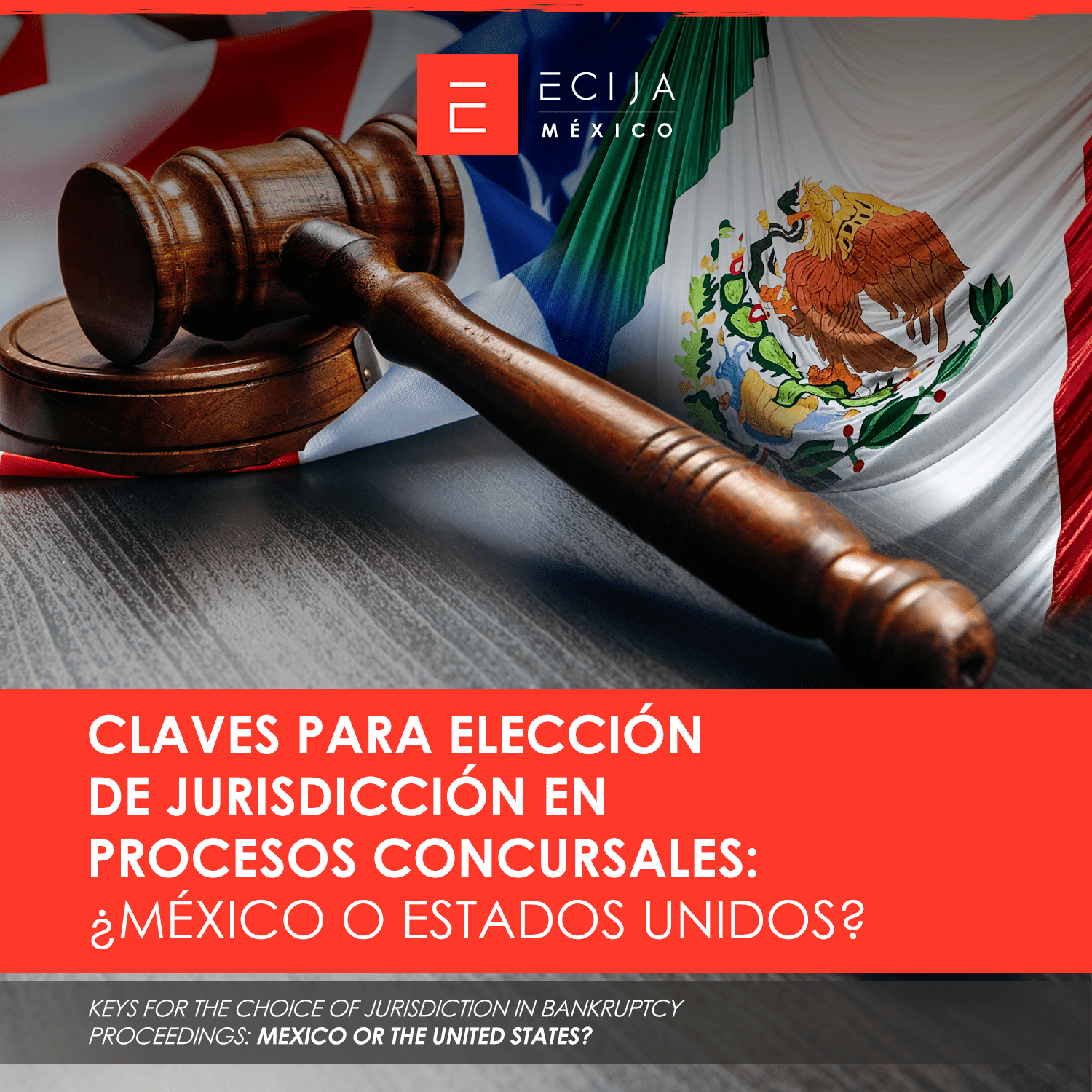Keys for the choice of jurisdiction in bankruptcy proceedings: Mexico or the United States?
Article published by Foro Juridico.
In the complicated maze of bankruptcy proceedings, choosing the right jurisdiction is not just a decision, it is a critical art, especially in the Mexican context. This article examines bankruptcy proceedings, highlighting the stages and efficiency of the Mexican judicial system and comparing them with those of the U.S. system. We will explore why numerous companies are shifting their focus to the United States in search of more favorable solutions.
Legal and Regulatory Framework
Before making any decision, it is essential to thoroughly understand the legal and regulatory framework governing bankruptcy proceedings in Mexico.
The general rule is that a merchant that defaults in the payment of its obligations on a general basis will be declared in bankruptcy, meaning the default in its payment obligations to two or more different creditors and that the following conditions are present:
- (I) That of those overdue obligations referred to above, those that are at least 30 days overdue represent 35% (thirty-five percent) or more of all the obligations owed by the merchant as of the date on which the petition or petition for bankruptcy has been filed; and,
- (II) That the merchant does not have the assets to meet at least 80% (eighty percent) of its overdue obligations as of the date of filing of the claim or request[1] .
However, it will be understood that a merchant is in general default in the payment of its obligations when:
- (a) The merchant requests its declaration of bankruptcy and is located in any of the cases set forth in the preceding paragraph; or,
- (b) Any creditor or Agent of the Federal Public Prosecutor’s Office has filed for the declaration of bankruptcy of the merchant and the merchant is located in any of the cases set forth in sections I or II above.
Thus, the LCM provides for the possibility that the merchant itself may request the insolvency proceeding, as well as that a creditor or the Federal Public Prosecutor’s Office may demand it.
Pursuant to Article 2 of the LCM, the insolvency proceeding consists of two successive stages, called conciliation and bankruptcy, which basically implies that, in the first stage, the company attempts to survive and in the second stage it must be liquidated due to the unfeasibility of its operational continuity.
Efficiency of the Judicial System
The efficiency of the judicial system in a given jurisdiction is a key factor. Researching the workload of the courts, the availability of resources and the experience of judges in bankruptcy cases can provide valuable insight. A streamlined and efficient process not only reduces costs, but also expedites the recovery and restructuring of the company.
Although the enactment of the Bankruptcy Law was intended to streamline the processes vs. the repealed Bankruptcy and Suspension of Payments Law, in which the processes could take dozens of years, the reality is that although the law establishes several deadlines for the conciliation stage (185 days plus an additional 180 days), in practice these deadlines are not necessarily met to the letter.
Another issue to take into consideration is that related to the precautionary measures, necessary and urgent to protect the assets of the company or the interests of the creditors, which are requested with the insolvency proceeding, being in most cases complex the request in Mexico, the justification for its granting, as well as the granting by the Judge.
Previous Experiences and Precedents
Even though the LCM dates back to the year 2000, very few cases are heard by the judges in this regard. . According to statistics from June 1 to November 30, 2022, published by the Instituto de Especialistas en Concursos Mercantiles (IFECOM)[2] , from 2000 to 2022, 903 bankruptcy proceedings have been carried out, of which 649 have been concluded.
This leads us to think that there is little experience in the matter and the lack of interest of Mexican companies to explore this procedure for their benefit or that of their creditors, taking into account that these are costly procedures, in most cases long and that they are not considered urgent for the judicial system, even though it is important to recognize the existence of two District Courts specialized in this matter throughout the country. .
This necessarily influences the decisions of the companies that have the possibility of filing their claim in Mexico or in the United States of America (given the large number of companies that seek this benefit in that nation).
Resolution Alternatives and Flexibility
Evaluating the resolution alternatives offered by each jurisdiction is essential. Some jurisdictions may provide greater flexibility in restructuring and allow for customized solutions. This flexibility can be crucial to adapt to the specific circumstances of the company and maximize the chances of success.
Basic differences between insolvency proceedings in Mexico and the U.S.
The choice of jurisdiction in a bankruptcy proceeding is a delicate task that requires a thorough analysis. Consideration of legal issues, judicial efficiency, previous experience, costs and business relationships are key elements in making an informed decision. By addressing these issues comprehensively, companies can increase their chances of a successful restructuring and protect their long-term interests. Ultimately, the choice of jurisdiction must be aligned with the business objectives and specific needs of the distressed company.
In this regard, it should be noted that the lack of agility and flexibility in Mexico causes judicial processes to be much longer than in the US. In both countries, the corresponding legislation includes Chapter 11 (Chapter 11) in the U.S., as well as Chapter 7 (Chapter 7), a simile of the LCM bankruptcy proceeding.
We have already mentioned the low appetite of Mexican companies to file for insolvency proceedings, either to reorganize or to carry out an orderly liquidation, which is also due to the fact that a large percentage of companies in our country are SMEs, which in many cases leads them to consider it more expensive to rescue the business than to start one.
As a result of the above, more and more Mexican companies see Chapter 11 as a safer and more efficient way out, basically for three reasons: the agility with which the judge hearing the case grants safeguard (precautionary) measures, the time period in which the company in bankruptcy can reach an agreement with its creditors, and mainly because in the U.S. it is common for companies in bankruptcy to obtain financing to maintain their operations and get out of the crisis, without the need for the authorization of the conciliator and the judge, as is the case in Mexico.
But how can a Mexican company file for Chapter 11 in the U.S.? The key requirement is that the majority of its assets or creditors must be located in the United States.
Ultimately, the choice of the correct jurisdiction in a bankruptcy proceeding is a crucial strategic maneuver. This analysis reveals not only the complexity of the Mexican system, but also the attractive agility of the U.S. system. For companies in crisis, the decision transcends mere legality; it becomes a choice that can define their future. While negotiating with creditors should always be the first step, understanding these differences and opportunities is essential for any company facing financial challenges.
________
Dispute Resolution Department of ECIJA Mexico
socios.mexico@ecija.com
[1] Pursuant to Article 10 of the Mexican Bankruptcy Law, assets are deemed to be (i) cash on hand and demand deposits, (ii) time deposits and investments whose maturity does not exceed 90 calendar days after the date of filing of the complaint or petition, (iii) customers and accounts receivable whose maturity does not exceed 90 calendar days after the date of filing of the complaint or petition, and (iv) securities for which purchase and sale transactions are regularly recorded on a regular basis, (iii)customers and accounts receivable whose maturity is not greater than 90 calendar days after the date of filing the claim or request, and (iv)securities for which purchase and sale transactions are regularly registered in the relevant markets, which could be sold within a maximum period of 30 banking days, whose valuation as of the date of filing the claim or request is known.
https://www.ifecom.cjf.gob.mx/resources/PDF/informesEst/6.pdf






